The Extraction of Ocean Tidal Loading from ASAR Differential Interferograms
Abstract
1. Introduction
2. Data Sets and Processing
2.1. InSAR and GPS Data
2.2. Data Processing
3. Methodology
3.1. Correction of the solid Earth tidal Effect, the Long-Wavelength Atmospheric Delay, and Orbital Error
3.2. Multi-Scale Decomposition Using the 2-D Wavelet Transform Method
4. The Ocean Tidal Loading Effect in a D-InSAR Interferogram
4.1. The OTL Displacements Calculated Based on FES2014b Tide Model
4.2. The OTL Displacements Estimated by Kinematic PPP
4.3. The OTL Displacements Extracted From the Differential Interferograms
5. Conclusions
Author Contributions
Funding
Acknowledgments
Conflicts of Interest
Appendix A
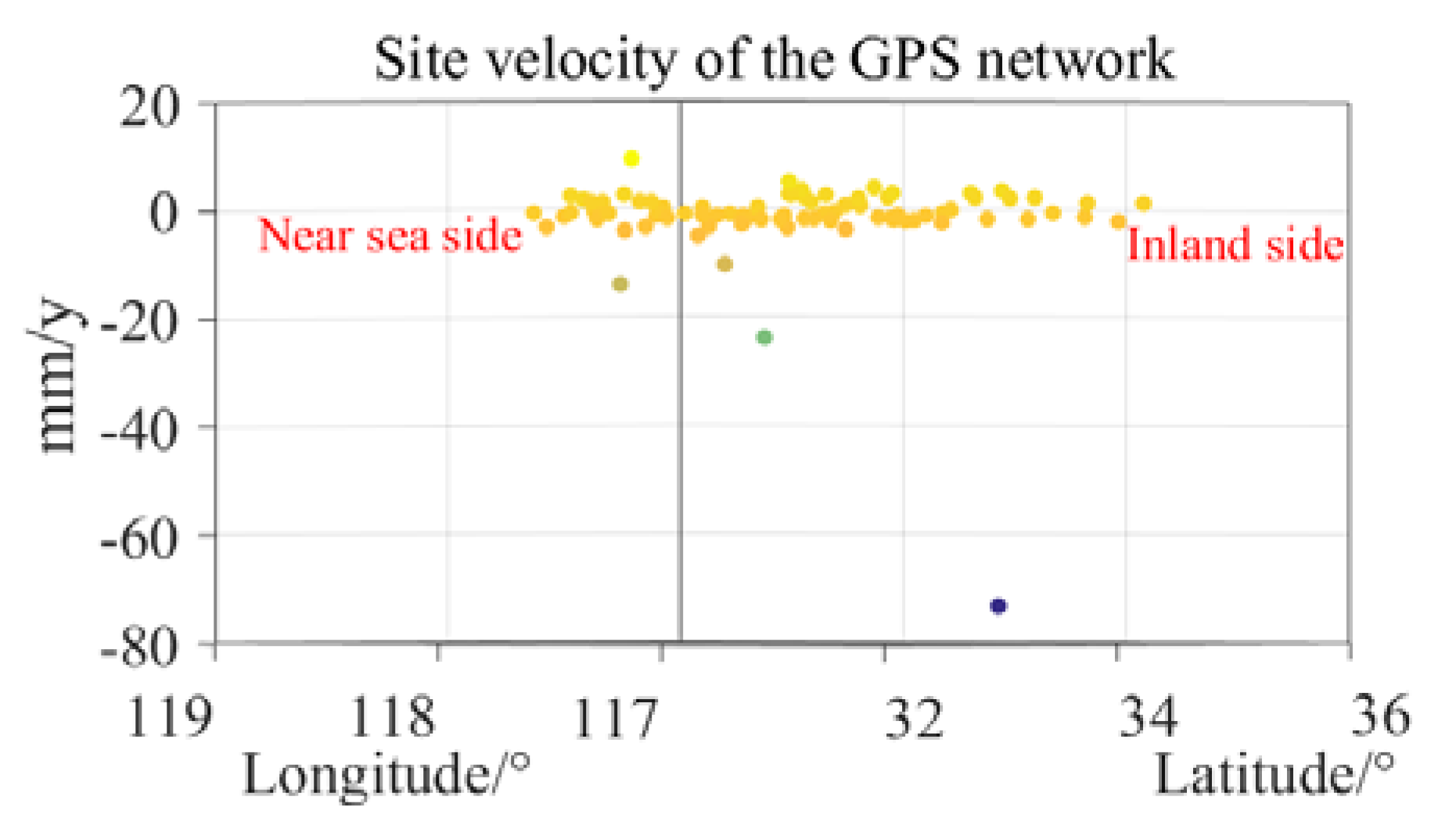
References
- Penna, N.T.; King, M.A.; Stewart, M.P. GPS height time series: Short-period origins of spurious long-period signals. J. Geophys. Res. Solid Earth 2007, 112. [Google Scholar] [CrossRef]
- Yuan, L.; Chao, B.F.; Ding, X.; Zhong, P. The tidal displacement field at Earth’s surface determined using global GPS observations. J. Geophys. Res. Solid Earth 2013, 118, 2618–2632. [Google Scholar] [CrossRef]
- Thomas, I.D.; King, M.A.; Clarke, P.J. A comparison of GPS, VLBI and model estimates of ocean tide loading displacements. J. Geod. 2007, 81, 359–368. [Google Scholar] [CrossRef]
- Boy, J.P.; Llubes, M.; Hinderer, J.; Florsch, N. A comparison of tidal ocean loading models using superconducting gravimeter data. J. Geophys. Res. Solid Earth 2003, 108. [Google Scholar] [CrossRef]
- Jolivet, R.; Agram, P.S.; Lin, N.Y.; Simons, M.; Doin, M.P.; Peltzer, G.; Li, Z. Improving InSAR geodesy using global atmospheric models. J. Geophys. Res. Solid Earth 2014, 119, 2324–2341. [Google Scholar] [CrossRef]
- Penna, N.T.; Clarke, P.J.; Bos, M.S.; Baker, T.F. Ocean tide loading displacements in western Europe: 1. Validation of kinematic GPS estimates. J. Geophys. Res. Solid Earth 2015, 120, 6523–6539. [Google Scholar] [CrossRef]
- Yuan, L.G.; Ding, X.L.; Zhong, P.; Chen, W.; Huang, D.F. Estimates of ocean tide loading displacements and its impact on position time series in Hong Kong using a dense continuous GPS network. J. Geod. 2009, 83, 999. [Google Scholar] [CrossRef]
- Urschl, C.; Dach, R.; Hugentobler, U.; Schaer, S.; Beutler, G. Validating ocean tide loading models using GPS. J. Geod. 2005, 78, 616–625. [Google Scholar] [CrossRef]
- DiCaprio, C.J.; Simons, M. Importance of ocean tidal load corrections for differential InSAR. Geophys. Res. Lett. 2008, 35, L22309. [Google Scholar] [CrossRef]
- Peng, W.; Wang, Q.; Cao, Y. Analysis of ocean tide loading in differential InSAR measurements. Remote Sens. 2017, 9, 101. [Google Scholar] [CrossRef]
- Matsumoto, K.; Takanezawa, T.; Ooe, M. Ocean tide models developed by assimilating TOPEX/POSEIDON altimeter data into hydrodynamical model: A global model and a regional model around Japan. J. Oceanogr. 2000, 56, 567–581. [Google Scholar] [CrossRef]
- Lyard, F.; Lefevre, F.; Letellier, T.; Francis, O. Modelling the global ocean tides: Modern insights from FES2004. Ocean Dyn. 2006, 56, 394–415. [Google Scholar] [CrossRef]
- Savcenko, R.; Bosch, W. EOT11a-Empirical Ocean Tide Model from Multi-Mission Satellite Altimetry; Deutsches Geodätisches Forschungsinstitut (DGFI): Munich, Germany, 2012. [Google Scholar]
- Egbert, G.D.; Erofeeva, S.Y. Efficient inverse modeling of barotropic ocean tides. J. Atmos. Ocean. Technol. 2002, 19, 183–204. [Google Scholar] [CrossRef]
- Wei, G.G.; Wang, Q.J.; Peng, W. Accurate Evaluation of Vertical Tidal Displacement Determined by GPS Kinematic Precise Point Positioning: A Case Study of Hong Kong. Sensors 2019, 19, 2559. [Google Scholar] [CrossRef]
- Gabriel, A.K.; Goldstein, R.M.; Zebker, H.A. Mapping small elevation changes over large areas: Differential radar interferometry. J. Geophys. Res. Solid Earth 1989, 94, 9183–9191. [Google Scholar] [CrossRef]
- Bähr, H.; Hanssen, R.F. Reliable estimation of orbit errors in spaceborne SAR interferometry. J. Geod. 2012, 86, 1147–1164. [Google Scholar] [CrossRef]
- Lin, Y.N.N.; Simons, M.; Hetland, E.A.; Muse, P.; DiCaprio, C. A multiscale approach to estimating topographically correlated propagation delays in radar interferograms. Geochem. Geophys. Geosyst. 2010, 11. [Google Scholar] [CrossRef]
- Cao, Y.; Li, Z.W.; Hu, J.; Duan, M.; Feng, G.C. Stochastic modeling for time series InSAR: With emphasis on atmospheric effects. J. Geod. 2018, 92, 185–204. [Google Scholar] [CrossRef]
- Schubert, A.; Jehle, M.; Small, D.; Meier, E. Mitigation of atmospheric perturbations and solid earth movements in a terrasar-x time-series. J. Geod. 2011, 86, 257–270. [Google Scholar] [CrossRef]
- Yu, C.; Li, Z.; Penna, N.T. Interferometric synthetic aperture radar atmospheric correction using a GPS-based iterative tropospheric decomposition model. Remote Sens. Environ. 2018. [Google Scholar] [CrossRef]
- Wang, Q.J.; Yu, W.Y.; Xu, B.; Wei, G.G. Assessing the Use of GACOS Products for SBAS-InSAR Deformation Monitoring a Case in Southern California. Sensors 2019, 19, 3894. [Google Scholar] [CrossRef]
- Tong, X.; Sandwell, D.T.; Smith-Konter, B. High-resolution interseismic velocity data along the San Andreas Fault from GPS and InSAR. J. Geophys. Res. Solid Earth 2013, 118, 369–389. [Google Scholar] [CrossRef]
- Simard, M.; DeGrandi, G.; Thomson, K.P.; Benie, G.B. Analysis of speckle noise contribution on wavelet decomposition of SAR images. IEEE Trans. Geosci. Remote Sens. 1998, 36, 1953–1962. [Google Scholar] [CrossRef]
- Shirzaei, M. A wavelet-based multitemporal DInSAR algorithm for monitoring ground surface motion. IEEE Geosci. Remote Sens. Lett. 2013, 10, 456–460. [Google Scholar] [CrossRef]
- Shirzaei, M.; Bürgmann, R. Topography correlated atmospheric delay correction in radar interferometry using wavelet transforms. Geophys. Res. Lett. 2012, 39. [Google Scholar] [CrossRef]
- Wegmüller, U.; Santoro, M.; Werner, C.; Strozzi, T.; Wiesmann, A.; Lengert, W. DEM generation using ERS–ENVISAT interferometry. J. Appl. Geophys. 2009, 69, 51–58. [Google Scholar] [CrossRef]
- Werner, C.L.; Wegmüller, U.; Strozzi, T. Processing strategies for phase unwrapping for InSAR applications. In Proceedings of the European Conference on Synthetic Aperture Radar EUSAR 2002, Cologne, Germany, 4–6 June 2002. [Google Scholar]
- Béjar-Pizarro, M.; Socquet, A.; Armijo, R.; Carrizo, D.; Genrich, J.; Simons, M. Andean structural control on interseismic coupling in the north chile subduction zone. Nat. Geosci. 2013, 6, 462–467. [Google Scholar] [CrossRef]
- Bock, Y. Detection of arbitrarily large dynamic ground motions with a dense high-rate GPS network. Geophys. Res. Lett. 2004, 31, L06604. [Google Scholar] [CrossRef]
- Agnew, D.C. NLOADF: A program for computing ocean-tide loading. J. Geophys. Res. Solid Earth 1997, 102, 5109–5110. [Google Scholar] [CrossRef]
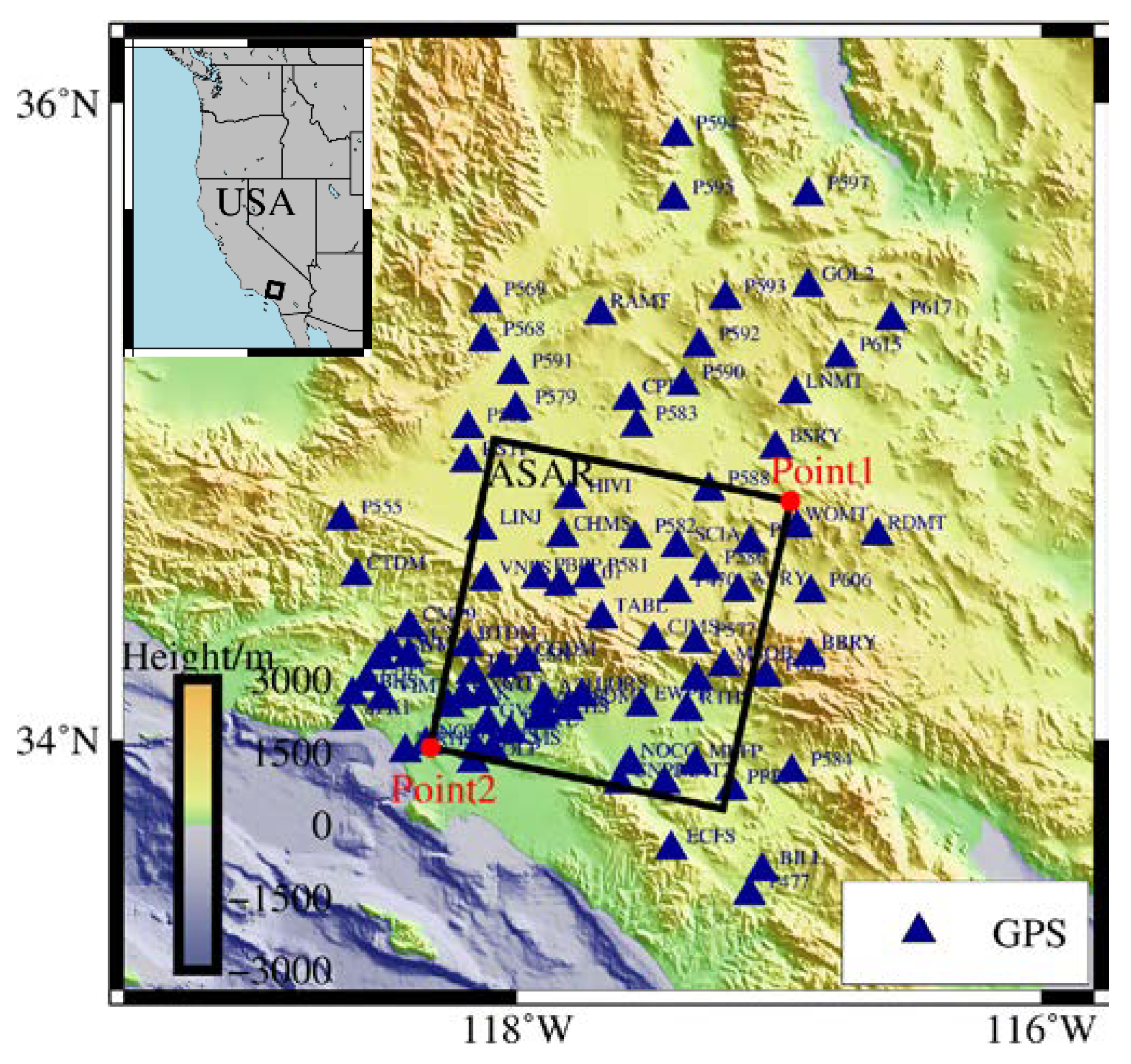
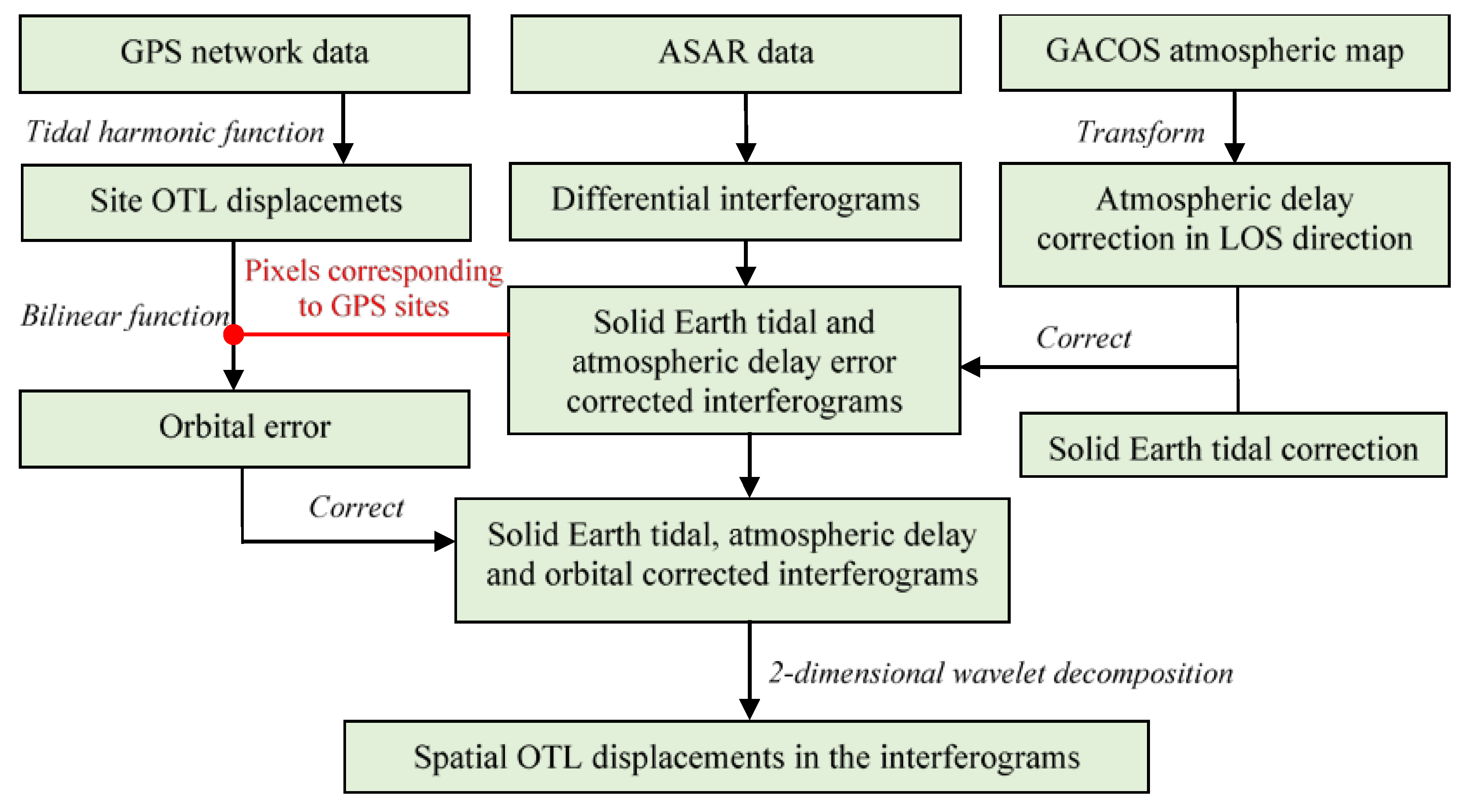
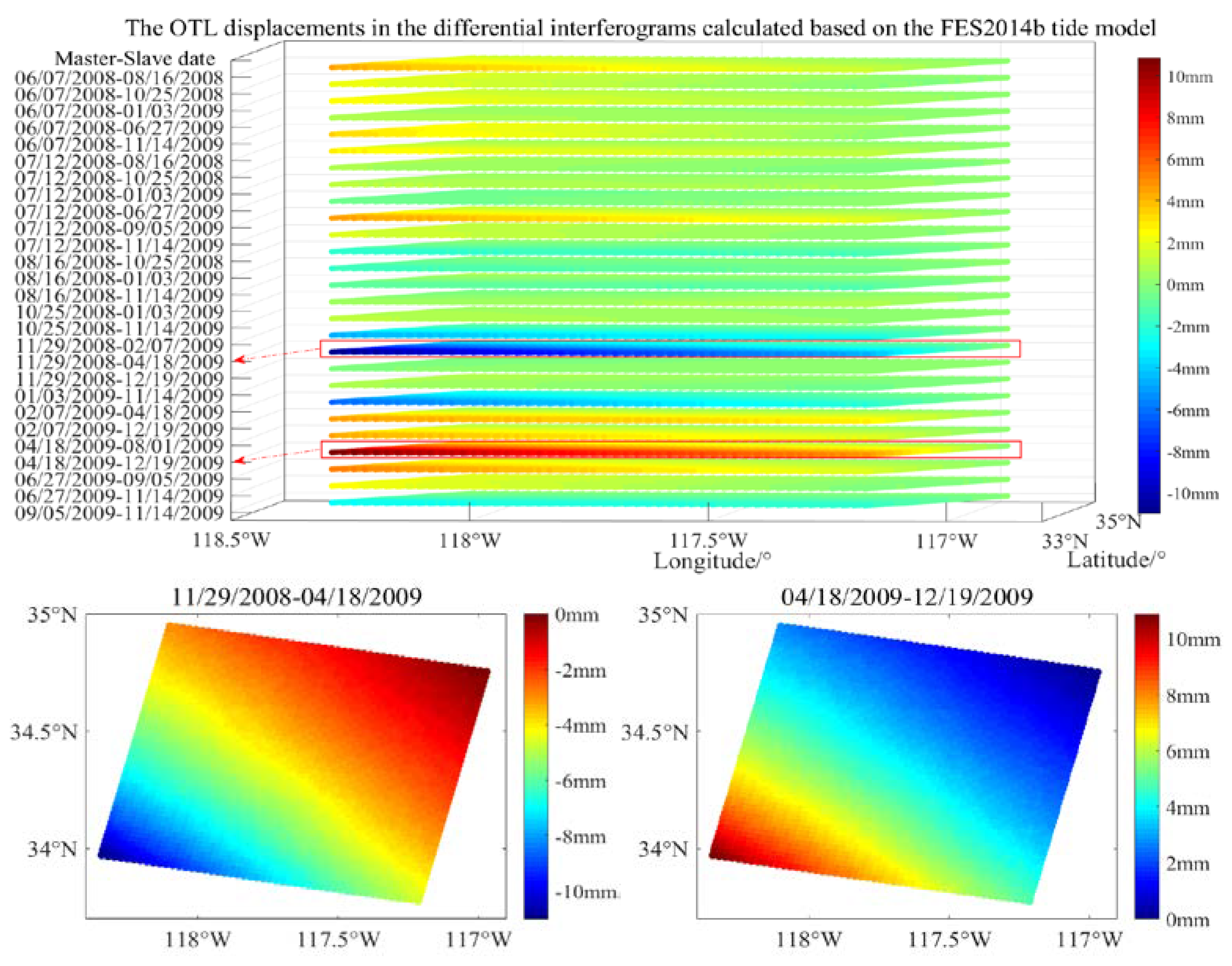
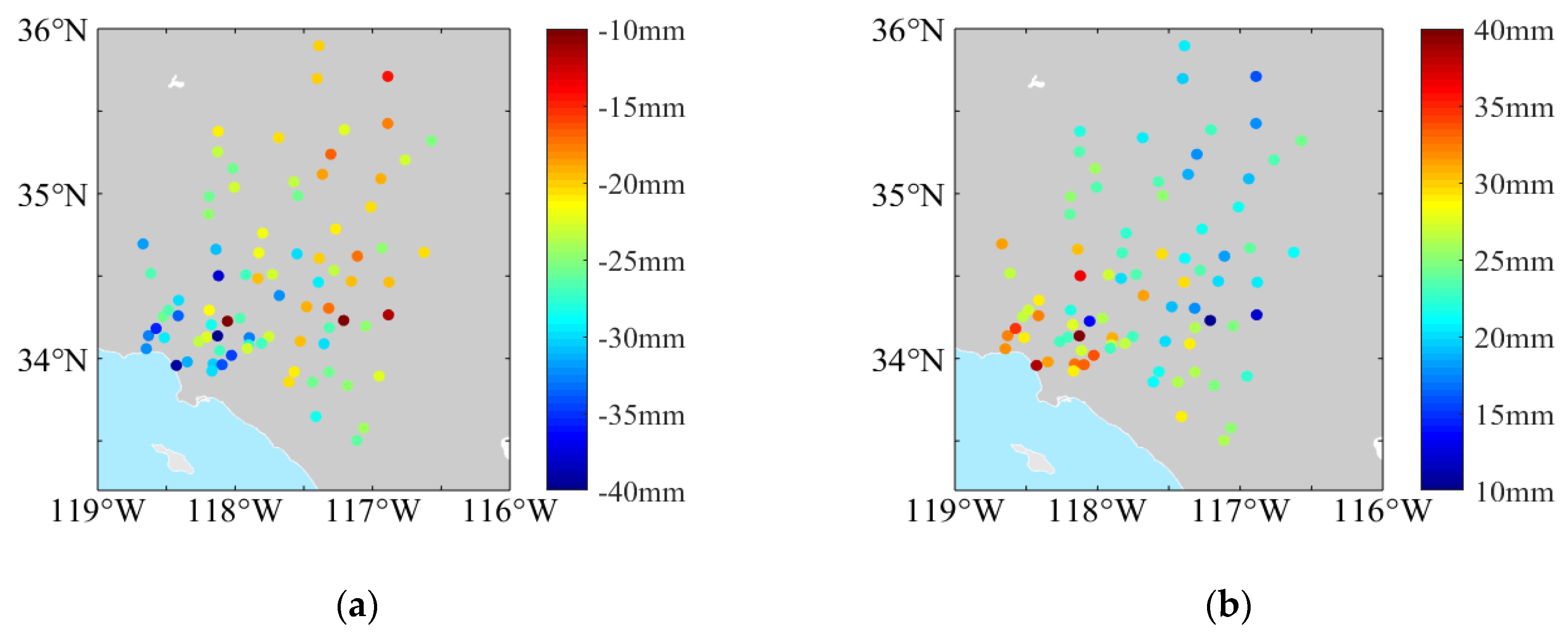


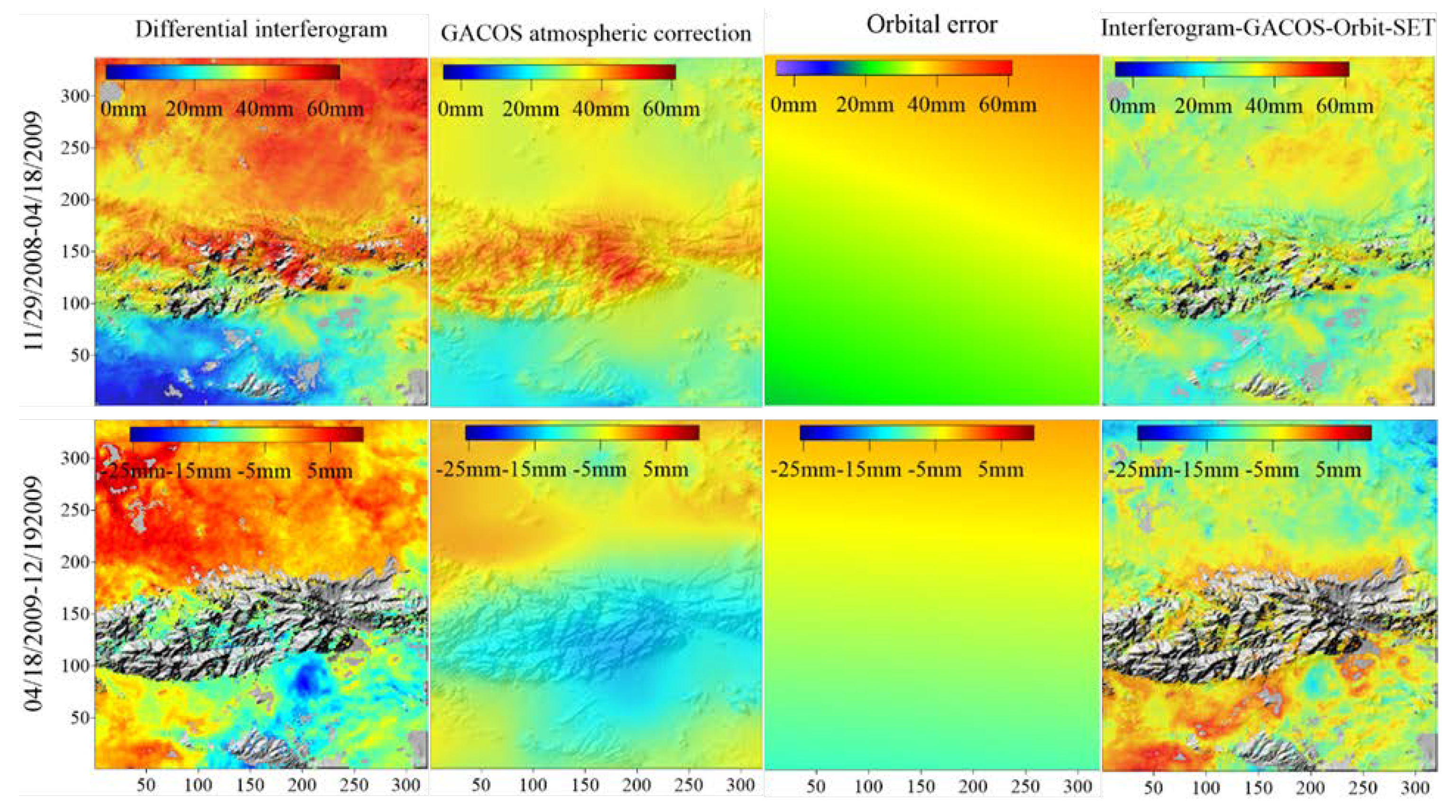

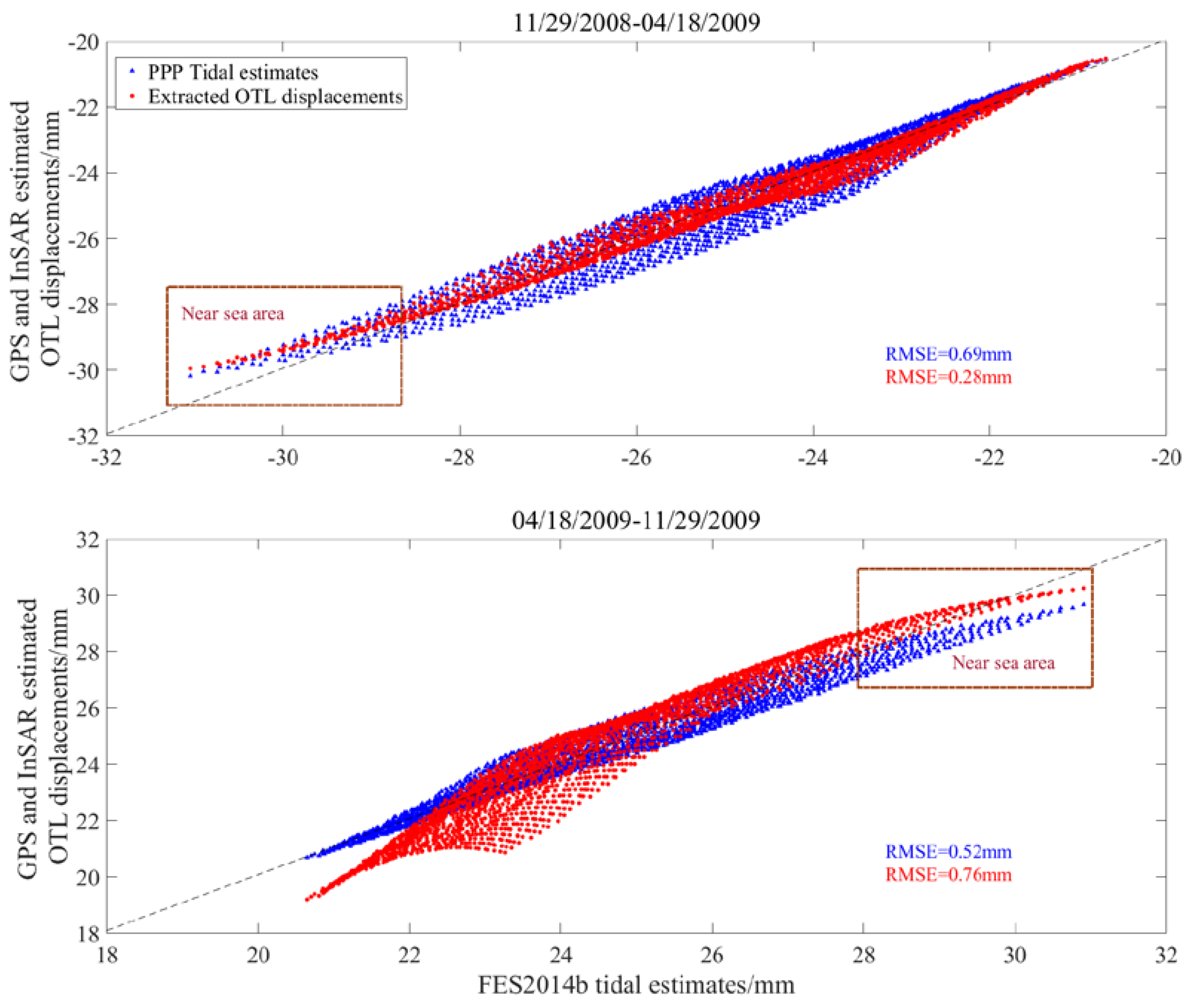
| Imaging Date | Relative Spatial Variation of the OTL Displacement/mm | Imaging Date | Relative Spatial Variation of the OTL Displacement/mm |
| 7 June 2008 | 2.4 | 18 April 2009 | 4.4 |
| 12 July 2008 | 0.9 | 27 June 2009 | 1.6 |
| 16 August 2008 | −1.8 | 1 August 2009 | 0.3 |
| 25 October 2008 | 0.2 | 5 September 2009 | −3.7 |
| 29 November 2008 | −6.5 | 14 November 2009 | −0.9 |
| 3 January 2009 | −0.2 | 19 December 2009 | −6.4 |
| 7 February 2009 | −1.8 |
© 2020 by the authors. Licensee MDPI, Basel, Switzerland. This article is an open access article distributed under the terms and conditions of the Creative Commons Attribution (CC BY) license (http://creativecommons.org/licenses/by/4.0/).
Share and Cite
Peng, W.; Wang, Q.; Cao, Y. The Extraction of Ocean Tidal Loading from ASAR Differential Interferograms. Sensors 2020, 20, 632. https://doi.org/10.3390/s20030632
Peng W, Wang Q, Cao Y. The Extraction of Ocean Tidal Loading from ASAR Differential Interferograms. Sensors. 2020; 20(3):632. https://doi.org/10.3390/s20030632
Chicago/Turabian StylePeng, Wei, Qijie Wang, and Yunmeng Cao. 2020. "The Extraction of Ocean Tidal Loading from ASAR Differential Interferograms" Sensors 20, no. 3: 632. https://doi.org/10.3390/s20030632
APA StylePeng, W., Wang, Q., & Cao, Y. (2020). The Extraction of Ocean Tidal Loading from ASAR Differential Interferograms. Sensors, 20(3), 632. https://doi.org/10.3390/s20030632




